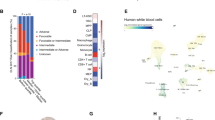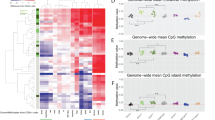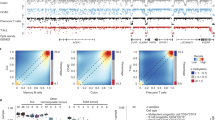Abstract
The Ink4b gene (Cdkn2b) encodes p15Ink4b, a cyclin-dependent kinase inhibitor. It has been implicated in playing a role in the development of acute myeloid leukemia (AML) in man, since it is hypermethylated with high frequency. We provide evidence that the gene is a tumor suppressor for myeloid leukemia in mice. The evidence is twofold: (1) retrovirus-induced myeloid leukemias of the myelomonocytic phenotype were found to have hypermethylation of the 5′ CpG island of the Ink4b gene, and this could be correlated with reduced mRNA expression, as demonstrated by TaqMan real-time PCR. p15Ink4b mRNA expression in a leukemia cell line, with hypermethylation at the locus, was induced following treatment with 5-aza-2′-deoxycytidine. (2) Targeted deletion of one allele in mice by removal of exon 2 increases their susceptibility to retrovirus-induced myeloid leukemia. Mice deficient in both alleles were not more susceptible to myeloid disease than those deficient in one allele, raising the possibility that there are opposing forces related to the development of myeloid leukemia in Ink4b null mice.
This is a preview of subscription content, access via your institution
Access options
Subscribe to this journal
Receive 50 print issues and online access
$259.00 per year
only $5.18 per issue
Buy this article
- Purchase on Springer Link
- Instant access to full article PDF
Prices may be subject to local taxes which are calculated during checkout










Similar content being viewed by others
References
Amanullah A, Hoffman B and Liebermann DA . (2000). Blood, 96, 475–482.
Bonin A, Reid SW and Tessarollo L . (2001). Methods Mol. Biol., 158, 121–134.
Cameron EE, Bachman KE, Myohanen S, Herman JG and Baylin SB . (1999a). Nat. Genet., 21, 103–107.
Cameron EE, Baylin SB and Herman JG . (1999b). Blood, 94, 2445–2451.
Chin L, Pomerantz J and DePinho RA . (1998). Trends Biochem. Sci., 23, 291–296.
Drexler HG . (1998). Leukemia, 12, 845–859.
Fekete E . (1938). Am. J. Pathol., 14, 557–578.
Hannon G J and Beach D . (1994). Nature, 371, 257–261.
Haviernik P, Schmidt M, Hu X and Wolff L . (2003). Oncogene, 22, 1600–1610.
Herman JG, Graff JR, Myohanen S, Nelkin BD and Baylin SB . (1996). Proc. Natl. Acad. Sci. USA, 93, 9821–9826.
Jones PA and Laird PW . (1999). Nat. Genet., 21, 163–167.
Kalbfleisch JD and Prentice RL . (1980). The Statistical Analysis of Failure Time Data. Wiley and Sons: New York, pp. 16–19.
Kamijo T, Zindy F, Roussel MF, Quelle DE, Downing JR, Ashmun RA, Grosveld G and Sherr CJ . (1997). Cell, 91, 649–659.
Kogan SC, Ward JM, Anver MR, Berman JJ, Brayton C, Cardiff RD, Carter JS, de Coronado S, Downing JR, Fredrickson TN, Haines DC, Harris AW, Harris NL, Hiai H, Jaffe ES, MacLennan IC, Pandolfi PP, Pattengale PK, Perkins AS, Simpson RM, Tuttle MS, Wong JF and Morse III HC . (2002). Blood, 100, 238–245.
Krimpenfort P, Quon KC, Mooi WJ, Loonstra A and Berns A . (2001). Nature, 413, 83–86.
Latres E, Malumbres M, Sotillo R, Martin J, Ortega S, Martin-Caballero J, Flores JM, Cordon-Cardo C and Barbacid M . (2000). EMBO J., 19, 3496–3506.
Li L-C and Dahiya R . (2002). Bioinformatics, 18, 1427–1431.
Malumbres M, Perez deC I, Santos J, Melendez B, Mangues R, Serrano M, Pellicer A and Fernandez-Piqueras J . (1997). Oncogene, 14, 1361–1370.
Nazarov V, Hilbert D and Wolff L . (1994). Virology, 205, 479–485.
Rowe WP, Pugh WE and Hartley JW . (1970). Virology, 42, 1136–1139.
Ruas M and Peters G . (1998). Biochim. Biophys. Acta, 1378, F115–F177.
Ryan KM, Phillips AC and Vousden KH . (2001). Curr. Opin. Cell Biol., 13, 332–337.
Schmidt M, Koller R, Haviernik P, Bies J, Maciag K and Wolff L . (2001). Oncogene, 20, 6205–6214.
Schmidt M, Nazarov V, Stevens L, Watson R and Wolff L . (2000). Mol. Cell. Biol., 20, 1970–1981.
Sharpless NE, Bardeesy N, Lee KH, Carrasco D, Castrillon DH, Aguirre AJ, Wu EA, Horner JW and DePinho RA . (2001). Nature, 413, 86–91.
Sherr CJ . (2001). Nat. Rev. Mol. Cell Biol., 2, 731–737.
Stirewalt DL and Radich JP . (2000). Hematology, 5, 15–25.
Teofili L, Morosetti R, Martini M, Urbano R, Putzulu R, Rutella S, Pierelli L, Leone G and Larocca LM . (2000). Exp. Hematol., 28, 519–526.
Tessarollo L . (2001). Methods Mol. Biol., 158, 47–63.
Wolff L, Schmidt M, Koller R, Haviernik P, Watson R, Bies J and Maclag K . (2001). Blood Cells Mol. Dis., 27, 422–428.
Wolff L, Koller R, Hu X and Anver MR . (2003). J. Virol., 77, 4965–4971.
Acknowledgements
We thank Miriam Anver for her expert assistance in diagnosing the leukemias, Elise Bowman for help running the real-time PCR assays, and Ricardo Dreyfuss for excellent preparation of photographic depictions of tissues and cells.
Author information
Authors and Affiliations
Corresponding author
Rights and permissions
About this article
Cite this article
Wolff, L., Garin, M., Koller, R. et al. Hypermethylation of the Ink4b locus in murine myeloid leukemia and increased susceptibility to leukemia in p15Ink4b-deficient mice. Oncogene 22, 9265–9274 (2003). https://doi.org/10.1038/sj.onc.1207092
Received:
Revised:
Accepted:
Published:
Issue Date:
DOI: https://doi.org/10.1038/sj.onc.1207092
Keywords
This article is cited by
-
Role of microRNAs, circRNAs and long noncoding RNAs in acute myeloid leukemia
Journal of Hematology & Oncology (2019)
-
The role of tumor suppressor p15Ink4b in the regulation of hematopoietic progenitor cell fate
Blood Cancer Journal (2013)
-
Identification of Zfp521/ZNF521 as a cooperative gene for E2A-HLF to develop acute B-lineage leukemia
Oncogene (2010)
-
Overexpression/enhanced kinase activity of BCR/ABL and altered expression of Notch1 induced acute leukemia in p210BCR/ABL transgenic mice
Oncogene (2008)
-
JunB is a gatekeeper for B-lymphoid leukemia
Oncogene (2007)



